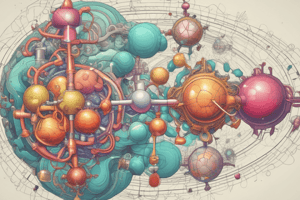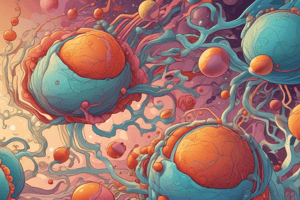Podcast
Questions and Answers
What is metabolism also known as?
What is metabolism also known as?
- Cellular response
- Biochemical pathway
- Biochemical reaction
- Biotransformation (correct)
What is the main difference between catabolic and anabolic reactions?
What is the main difference between catabolic and anabolic reactions?
- Catabolic reactions consume energy, while anabolic reactions produce energy
- Catabolic reactions produce energy, while anabolic reactions consume energy
- Catabolic reactions occur in the mitochondria, while anabolic reactions occur in the cytosol
- Catabolic reactions involve breakdown of molecules, while anabolic reactions involve synthesis of molecules (correct)
What is the net product of glycolysis in terms of ATP molecules?
What is the net product of glycolysis in terms of ATP molecules?
- 8 ATP molecules
- 6 ATP molecules
- 4 ATP molecules
- 2 ATP molecules (correct)
What is the function of phosphofructokinase 1 enzyme in glycolysis?
What is the function of phosphofructokinase 1 enzyme in glycolysis?
What is the byproduct of glycolysis that can be used to generate ATP in subsequent reactions?
What is the byproduct of glycolysis that can be used to generate ATP in subsequent reactions?
What is the purpose of the first step in glycolysis, where glucose is phosphorylated to glucose-6-phosphate?
What is the purpose of the first step in glycolysis, where glucose is phosphorylated to glucose-6-phosphate?
What is the end product of glycolysis that can be further metabolized in aerobic respiration?
What is the end product of glycolysis that can be further metabolized in aerobic respiration?
What is the meaning of NAD in NADH?
What is the meaning of NAD in NADH?
What happens to glucose in the first stage of glycolysis?
What happens to glucose in the first stage of glycolysis?
Where does anaerobic respiration occur?
Where does anaerobic respiration occur?
What is the result of the Cori Cycle?
What is the result of the Cori Cycle?
How many ATP are needed for the Cori Cycle?
How many ATP are needed for the Cori Cycle?
What enzyme converts R-lactate to pyruvate?
What enzyme converts R-lactate to pyruvate?
What is gluconeogenesis?
What is gluconeogenesis?
Where does gluconeogenesis occur?
Where does gluconeogenesis occur?
What is the role of pyruvate carboxylase?
What is the role of pyruvate carboxylase?
Flashcards are hidden until you start studying
Study Notes
Metabolism
- Metabolism is the interconversion of biomolecules using chemical reactions, also known as biotransformation.
- It can be subdivided into catabolism and anabolism.
Catabolism
- Catabolic degradation reactions produce:
- Chemical energy (ATP)
- Ion gradients
- Mechanical energy (muscle contraction)
- Reducing agents (NADH and NADPH)
Anabolism
- Anabolic (biosynthetic) reactions:
- Store energy
- Produce macromolecules and cellular structures
Metabolic Reactions
- Biological reactions are in a state of flux.
- Many reactions are endothermic and unfavourable, so they need energy from ATP hydrolysis.
- Metabolism needs to balance energy (ATP), reducing agents, and the amounts of small molecules.
Biosynthetic Reactions
- Typically convert between reduced and oxidized forms.
- NAD stands for Nucleotide Adenine Dinucleotide.
Glycolysis
- Glycolysis is the degradation of glucose in the cytosol.
- It consists of 3 stages.
First Half of Glycolysis
- Glucose is phosphorylated to Glucose-6-phosphate.
- Glucose-6-phosphate is isomerized to Fructose-6-phosphate.
- Fructose-6-phosphate is converted to Fructose-1,6-bisphosphate.
Second Half of Glycolysis
- Fructose-1,6-bisphosphate is converted to dihydroxyacetone phosphate and glyceraldehyde-3-phosphate.
- Dihydroxyacetone phosphate is converted to glyceraldehyde-3-phosphate.
- Each step is repeated twice as 2x glyceraldehyde-3-phosphate molecules are generated for each glucose molecule.
Net Products of Glycolysis
- 2 ATP
- 2 NADH
- 2 pyruvate
Control Factor in Glycolysis
- Phosphofructokinase 1 enzyme mediates flux through the glycolytic pathway.
Anaerobic Respiration
- Occurs in muscle during anaerobic exercise.
- Pyruvate is reduced to R-lactate in the absence of oxygen.
- NADH is oxidized to NAD+, which allows glycolysis to continue under anaerobic conditions.
- R-lactate can be reoxidized to pyruvate using NAD+.
Cori Cycle
- Recycles R-lactate to glucose.
- Steps:
- Lactate is transported from muscle to liver in the blood.
- Lactate is converted to pyruvate by lactate dehydrogenase.
- Pyruvate is converted to glucose by gluconeogenesis in the liver.
- 6 ATP are needed for the Cori Cycle, with 2 ATP coming from glycolysis.
Gluconeogenesis
- Biosynthesis of glucose from non-carbohydrate precursors in liver cytosol.
- Occurs in liver cytosol, with the exception of the oxaloacetate step, which occurs in liver mitochondria.
- Steps:
- R-lactate is converted to pyruvate.
- ATP, CO2, and pyruvate make oxaloacetate in mitochondria.
- Oxaloacetate is exported to cytosol and converted to phosphoenolpyruvate.
- Bisphosphatase and phosphatase convert fructose-1,6-bisphosphate to glucose.
Enzymes
- Lactate dehydrogenase converts R-lactate to pyruvate.
- Pyruvate carboxylase controls the balance between degradation and synthesis of glucose.
- Phosphatase allows the export of glucose to other tissues.
Mitochondria
- Roles:
- Aerobic respiration
- Deamination and urea formation
Studying That Suits You
Use AI to generate personalized quizzes and flashcards to suit your learning preferences.




